Electrical Installation Condition Report
Testing is carried out in accordance with the 18th Edition of the IEE Wiring Regulations, BS7671:2018+A3:2024
Why do electrical installations need to be checked?
'The Electrical Safety Standards in the Private Rented Sector Regulations 2020' is a new requirement for all landlords to have the electrical installation tested and inspected every 5 years.
'The Electricity at Work Regulations 1989' places a legal responsibility on employers and employees, as duty holders, to ensure that electrical systems used at work under their control are safe.
Electrical installations are subject to wear and tear. Cables buried throughout the house can deteriorate over time and can cause fires. Rodents chew cables. Using the latest instrument testing, hidden from view cables can be tested.
Circuit breakers will only operate correctly and save lives if the earth wire is of the correct size and soundly connected. If the Live or Neutral wire becomes disconnected over time you will know straight away because the light/socket stops working. When the earth wire becomes disconnected you do not know until you receive an electric shock and the protection device fails to operate. Instrument testing of the earth and confirmation that the resistance is correct for the type of fuse is a fundamental part of the Testing and Inspection process.
Having your home or office installation checked by a professional could save a life
"Electricity is a major cause of accidental fires in UK homes – over 20,000 each year.
An electrical installation is the wiring in a home including the electrical intake,
fusebox and the lighting and power circuits.
Causes of electrical fires
Nine out of 10 (89%) electrical fires are caused by electrical products.
11% are caused by faults in installations or by people not using installations properly.
By having the electrics in your home checked regularly and by taking some simple precautions with your electrical appliances, you can reduce the risk of fire."
Quote from www.electricalsafetyfirst.org.uk




Electrical Installation Condition Report
Testing is carried out in accordance with the 18th Edition of the IEE Wiring Regulations, BS7671:2018+A3:2024

Tel:07938 584746
Why do electrical installations need to be checked?
'The Electrical Safety Standards in the Private Rented Sector Regulations 2020' is a new requirement for all landlords to have the electrical installation tested and inspected every 5 years.
The Electricity at Work Regulations 1989 places a legal responsibility on employers and employees, as duty holders, to ensure that electrical systems used at work under their control are safe.
Electrical installations are subject to wear and tear. Cables buried throughout the house can deteriorate over time and can cause fires. Rodents chew cables. Using the latest instrument testing, hidden from view cables can be tested.
Circuit breakers will only operate correctly and save lives if the earth wire is of the correct size and soundly connected. If the Live or Neutral wire becomes disconnected over time you will know straight away because the light/socket stops working. When the earth wire becomes disconnected you do not know until you receive an electric shock and the protection device fails to operate. Instrument testing of the earth and confirmation that the resistance is correct for the type of fuse is a fundamental part of the Testing and Inspection process.
Having your home or office installation checked by a professional could save a life
"Electricity is a major cause of accidental fires in UK homes – over 20,000 each year.
An electrical installation is the wiring in a home including the electrical intake,
fusebox and the lighting and power circuits.
Causes of electrical fires
Nine out of 10 (89%) electrical fires are caused by electrical products.
11% are caused by faults in installations or by people not using installations properly.
By having the electrics in your home checked regularly and by taking some simple precautions with your electrical appliances, you can reduce the risk of fire."
Quote from www.electricalsafetyfirst.org.uk




